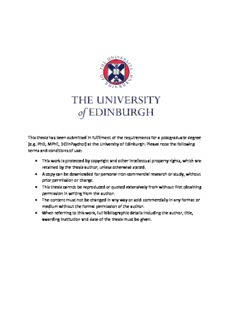
eg PhD, MPhil, DClinPsychol PDF
Preview eg PhD, MPhil, DClinPsychol
This thesis has been submitted in fulfilment of the requirements for a postgraduate degree (e.g. PhD, MPhil, DClinPsychol) at the University of Edinburgh. Please note the following terms and conditions of use: • This work is protected by copyright and other intellectual property rights, which are retained by the thesis author, unless otherwise stated. • A copy can be downloaded for personal non-commercial research or study, without prior permission or charge. • This thesis cannot be reproduced or quoted extensively from without first obtaining permission in writing from the author. • The content must not be changed in any way or sold commercially in any format or medium without the formal permission of the author. • When referring to this work, full bibliographic details including the author, title, awarding institution and date of the thesis must be given. Deep radio imaging of the UKIDSS Ultra Deep Survey field: the nature of the faint radio population, and the star-formation history of the Universe N I V E U R E S I H T T Y O H G F R E U DI N B Vinodiran Arumugam Athesissubmittedin fulfilmentoftherequirements forthedegreeofDoctorofPhilosophy to the UniversityofEdinburgh February 2013 Declaration Except where otherwise stated, the research undertaken in this thesis was the unaided workoftheauthor. Wheretheworkwasdoneincollaborationwithothers,asignificant contributionwas madeby theauthor. VinodiranArumugam February 2013 i Abstract The centrepiece of this thesis is a deep, new, high-resolution 1.4-GHz image coveringtheUnitedKingdomInfrared(IR)TelescopeIRDeepSkySurvey(UKIDSS) Ultra Deep Survey (UDS) legacy field. Deep pseudo-continuum observations were made using the Very Large Array, prior to its recent upgrade, in its A, B and DnC configurations. The resulting mosaic has a full-width-at-half-maximum synthesised beam width of 1.7arcsec and a point-source sensitivity of 60µJy (6σ) across ≈ ≈ the central 0.6deg2, while conserving flux from sources of extended emission. The full image covers 1.3deg2. I also present a catalogue containing over 1,000 radio emitters, having chosen the 6-σ threshold by maximisingthe number of radio sources withsecureoptical/near-IRcounterparts. Mostofthesourcesinthecatalogue( 90percent)lieinthesub-mJyfluxdensity ≈ regime. Deep, complementarydatacoveringawiderange ofwavelengthswas used to explore this faint radio population, whose nature remains controversial. It was found that 53 per cent of the sample comprise active galactic nuclei (AGN). AGN dominate at & 0.2mJy and remain a significant population down to 0.1mJy; at lower fluxes – theso-calledµJyradio population– star-forminggalaxiesbecomedominant. The radio sample presented here was also matched to Hubble Space Telescope imaging of the UDS field (which is part of the Cosmic Assembly Near-IR Deep Extragalactic Legacy Survey – CANDELS) to classify the faint radio population morphologically. These classifications were done using the Gini–M method. It was 20 found that a low fraction of AGN and SFGs are undergoing interactions and mergers, 33 9 and 13 7 per cent, respectively. The merger fraction does not appear to have ± ± evolved significantly since z 3. This suggests that mergers have played a relatively ∼ minor role in the assembly of galaxies and super-massive black holes – certainly less significantthanpreviouslythought. Finally, I present a study of cosmic star-formation activity as a function of stellar iii mass and redshift, exploiting panchromatic stacking. Mid-IR–through–radio images, including new data from Herschel, are stacked at the positions of a K-selected (i.e. an approximately mass-selected) sample in the UDS field. Specific star-formation rates (SSFR, i.e. star-formation rate per stellar mass, or the rate at which a galaxy is convertingitsgasintostars)werederivedfromUDSradioluminositiesmeasuredhere and stellar masses from the literature. The SSFR was found to be poorly correlated with stellar mass; it decreases with decreasing redshift; at a given mass, SSFR rises with redshift. These results indicate that at early epochs, galaxies were forming stars moreefficiently andat ahigherrate. iv Acknowledgements I would like to thank my parents, to whom I dedicate this thesis, for their unwavering encouragement and support over the years and for financially supporting me through thePhD.Withoutyourloveandsupport,thisambitionwouldneverhavebeenpossible. Iam alsograteful tomytwo sistersforalwaysbeing supportive. A big thank you to Rob Ivison for the guidance and support through the PhD and with this thesis - it took a while, but we got there in the end! You have been a great mentor to me - in astronomy and beyond. I would also like to thank Eduardo Ibar for being a patient teacher and Philip Best for his advice and guidanceon various aspects of my PhD. In addition, I would also like to acknowledge John Stott, Nathan Bourne and Marco Vieroforthedifferentcollaborationsinwhich Iwas involved. The PhD experience would not have been as enjoyable if not for the good times and great laughs I shared with my colleagues at the Observatory. In particular, I wouldliketothankWilliamTaylorforthefun,geekychatswesharedandforthegreat observing nights out; Trevor Back for being good company during late nights in the Vista Huts; Jack Mayo, Victoria Bruce and Alasdair Thomson for being great office mates and for the great office banter; and Paula Wilkie (and her magical stationery cupboard), Tania Johnston (especially for allowing me to rant at you in the mornings aboutthesisprogress),MartinBlack,SandyRogers,DavidHarvey,JuliaKennedyand Henry Pearce forbeing great companyovertheyears. AnotherpartofwhatmadethisPhDanenjoyableexperiencewastheopportunityto participateinpublicengagement,whichservedasapersistentreminderofmypassion forastronomy. Forthis,IwouldliketothankTaniaJohnston,DaveChalton,WillSharp and therest oftheVisitorCentre crew forthefuntimeswehad workingtogether. The work presented in this thesis was funded in part by the School of Physics and Astronomyand European Research CouncilAdvancedGrant, 321302,COSMICISM. v “Ifweknewwhat wewere doing,it wouldn’tbecalled research.” – Albert Einstein vii
Description: